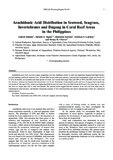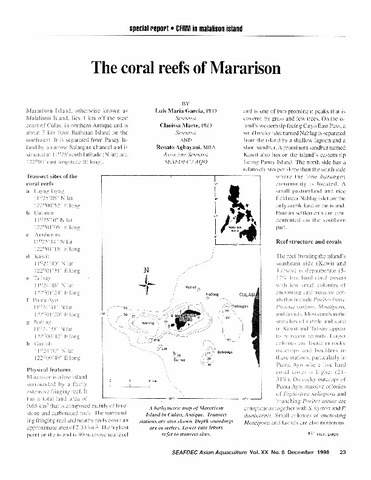Arachidonic acid is a major fatty acid in gonads of coral reef fishes and improves larval survival of rabbitfish Sigunus gutattus
| dc.contributor.author | Suloma, Ashraf | |
| dc.contributor.author | Chavez, Denny R. | |
| dc.contributor.author | Garibay, Esteban S. | |
| dc.contributor.author | Furuita, Hirofumi | |
| dc.contributor.author | Ogata, Hiroshi Y. | |
| dc.contributor.editor | Ortiz, Stewart L. | |
| dc.date.accessioned | 2017-01-12T02:53:55Z | |
| dc.date.available | 2017-01-12T02:53:55Z | |
| dc.date.issued | 2016 | |
| dc.identifier.citation | Suloma, A., Chavez, D. R., Garibay, E. S., Furuita, H., & Ogata, H. Y. (2016). Arachidonic acid is a major fatty acid in gonads of coral reef fishes and improves larval survival of rabbitfish Sigunus gutattus. In S. L. Ortiz (Ed.), Coral reefs: Ecosystems, Environmental Impact, and Current Threats (pp. 61-100). Hauppauge, New York: Nova Science Publishers, Inc. | en |
| dc.identifier.isbn | 9781634850810 | |
| dc.identifier.uri | http://hdl.handle.net/10862/3103 | |
| dc.description.abstract | The supply of wild fry of coral reef fishes for aquaculture has resulted in the deterioration of their natural stock status, causing public concern. Through a series of studies on the establishment of artificial-fry production technologies for coral reef fishes, we found that ovary, testis, eggs and fry of coral reef fishes have high or intermediate levels of arachidonic acid (ArA), which is a relatively minor component in temperate and cold-water species. In gonadal polar lipids of selected coral reef, in particular demersal fishes (19 species), ArA, eicosapentaenoic acid (EPA), and docosahexaenoic acid (DHA) levels ranged from 6.0% to 19.4%, from 0.9% to 6.2%, and from 7.9% to 27.8%, respectively. It is notable that the major highly unsaturated fatty acids (HUFA) of polar lipids in all coral reef fish gonads are DHA and ArA (not EPA) in a ratio of about 2:1. This result allowed us to speculate that not only DHA but also ArA may be nutritionally much important for egg development and larval growth in coral reef fishes. Thus, feeding trials were conducted to investigate the effects of dietary ArA supplementation on reproductive performance of coral reef rabbitfish (Siganus guttatus) broodstock. The number of spawning and the number of hatched larvae tended to be better in broodstock fed diets with ArA than in those fed a diet without ArA. Next, larval rearing tests were conducted to investigate survival and growth in rabbitfish fry fed live rotifers which had been enriched with or without ArA. Fry fed the rotifers enriched with a combination of DHA Protein Selco (Inve Aquaculture, Baasrode, Belgium) + 5% ArA (VEVODAR CRUDE ARACHIDONIC OIL, DSM Food Specialties, Delft, the Netherlands) showed significantly the best survival (44.4 ± 4.5% for Day 17 fry), although growth was not different among treatments. The present study indicates that ArA is not a minor component in coral reef fishes, and that dietary ArA is very promising for the improvement of fry production technologies of the coral reef fishes. | en |
| dc.description.sponsorship | The present study was financially supported by the collaborative project titled “Studies on Sustainable Production Systems of Aquatic Animals in Brackish Mangrove Areas” between Japan International Research Center for Agricultural Sciences, Japan and the Aquaculture Department, SEAFDEC, Philippines. | en |
| dc.language.iso | en | en |
| dc.publisher | Nova Science Publishers | en |
| dc.subject | docosahexaenoic acid | en |
| dc.subject | eicosapentaenoic acid | en |
| dc.subject | Siganus guttatus | en |
| dc.title | Arachidonic acid is a major fatty acid in gonads of coral reef fishes and improves larval survival of rabbitfish Sigunus gutattus | en |
| dc.type | Book chapter | en |
| dc.citation.spage | 61 | |
| dc.citation.epage | 100 | |
| dc.citation.bookTitle | Coral reefs: Ecosystems, Environmental Impact, and Current Threats | en |
| dc.subject.asfa | arachidonic acid | en |
| dc.subject.asfa | coral reefs | en |
| dc.subject.asfa | aquaculture | en |
| local.subject | arachidonic acid (ArA) | en |
| local.subject | DHA | en |
| local.subject | EPA | en |
| local.subject | coral reef | en |
| local.subject | fry production | en |
| local.subject | aquaculture | en |
このアイテムのファイル
| ファイル | サイズ | フォーマット | 閲覧 |
|---|---|---|---|
|
このアイテムに関連するファイルは存在しません。 |
|||
このアイテムは次のコレクションに所属しています
-
Books and Book Chapters [123]




